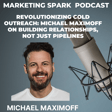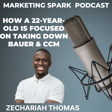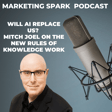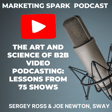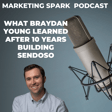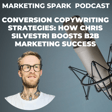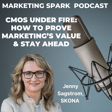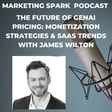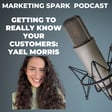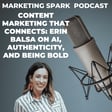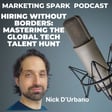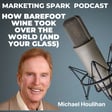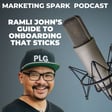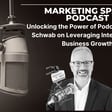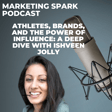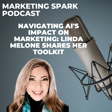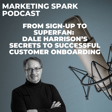Become a Creator today!Start creating today - Share your story with the world!
Start for free
00:00:00
00:00:01

The "Less is More" Approach to B2B SaaS Marketing
In this episode of Marketing Spark, Andrew Arocha, Drift's chief revenue officer, talks about how less (marketing) will be more amid more difficult economic conditions.
He talks about how companies will focus on revenue growth rather than brand awareness, the future of conferences (smaller and more intimate), best practices for ABM, and how companies should approach customer retention and churn.
Transcript
Challenges in B2B SaaS Marketing for 2023
00:00:07
Speaker
Where is the B2B SaaS marketing landscape heading in 2023? If you peered into a crystal ball, I'd suggest it would be cloudy and overcast. Given the more challenging economic conditions, the marketing landscape has shifted. Until early 22, marketing was about growth and customer acquisition. Today, it's about exploring new ways to attract and engage prospects and, as importantly, keep existing customers.
00:00:37
Speaker
For many B2B SaaS companies, it means the marketing mix strategically and tactically has to change. They need to take new and different approaches. And as we know, change can be hard. So it's easy to see how marketing could be a one step forward, one step backward proposition this year.
Evolving Marketing Strategies with Andrew Orocha
00:00:55
Speaker
On this episode of Marketing Spark, I'm talking with Andrew Orocha, Chief Revenue Officer with Drift, which pioneered conversational marketing.
00:01:04
Speaker
Andrew joined Drift in July after nearly five years at Oracle. When I was approached to have Andrew on the podcast, I was intrigued by how he's stepping back from the fray to figure out how marketing will evolve in 2023. Welcome to Marketing Spark, Andrew. Thank you. It's nice to be here. So this is a loaded question, but what do you see as the biggest changes in the B2B marketing mix in 2023?
Trends in B2B Marketing: Revenue Stacks and Alignment
00:01:32
Speaker
What channels or approaches are gaining momentum and what's falling out of favor? So, so I think that, uh, you know, the, the biggest trend I'm seeing is really the, in B2B marketing is the shift to, to revenue stack. Um, and so traditional marketing stacks, right? They're very, um, it would just, it was, it was harder to measure. And you know, the old adage of, you know, half of my marketing budget is wasted. I just don't know which half that it is that is wasted.
00:02:01
Speaker
And so there's a lot more focus on ensuring that you can actually tie.
00:02:05
Speaker
you know, the technology to results. And so, you know, what I'm seeing out there is kind of CMO CRO alignment a lot tighter now. And, you know, things like signal-based marketing, things like, you know, real site engagement in conversation marketing, obviously is a big part of that. And things like ABM strategies are starting to get a lot more focus and attention because they're, you know, they're easier to measure.
00:02:34
Speaker
And so, you know, I think that's one key trend. And I think, you know, some of the things, you know, I wouldn't say, you know, so much falling out of favor is just like, now, what do we prioritize? And, you know, I think it is those, you know, again, you're looking at things that tie to results that you can measure better or getting a lot more attention. Not that these are falling out of favor, but the bigger projects that, you know, are taking longer
00:02:57
Speaker
for instance, like, you know, CDPs, they had so much momentum and, you know, but it's hard work, right? It's a lot of hard work. And so I think, you know, some of those, I'm seeing those projects being put on hold for this year while companies retrench and start to think about like really intelligent ways they can spend, they can do more with less and kind of spend less to get more.
Balancing Immediate Revenue with Long-term Brand Awareness
00:03:20
Speaker
Yeah. It's an interesting landscape in the sense that
00:03:24
Speaker
Data allows companies to instantly assess whether marketing activities are successful or not. But what about the other side of the fence, the marketing that can't be measured, things like dark web and dark social and as important activities like brand awareness and thought leadership, which are more slow burn
00:03:49
Speaker
long-term propositions. How do marketers balance the need to drive results and revenue in the short term, but still position themselves for long-term success?
00:04:01
Speaker
I mean, that's a great question that we're, let's say for Drift, for example, too, where, you know, we have a really great brand and there's a lot of just activity and awareness of the Drift brand. So we're starting to pivot, you know, some of our budget to more, again, results oriented kind of, you know, like ABM strategies and things like that.
00:04:19
Speaker
I think that brand is absolutely still important. I think for 2023, it's going to take a bit of a backseat for a short period of time. I think that the things, like you said, that are more experiential and harder to measure,
00:04:39
Speaker
those will get less funding in 2023. Not that they'll go away, they'll absolutely still be spent on, you know, on awareness campaigns, on brand campaigns. There's things that you just need to do, right, to have awareness. But, you know, I think that, you know, where we're seeing the focus, especially as we said, the theme for 2023 that we're seeing is kind of do more with less.
Revenue Focus with Budget Constraints
00:04:59
Speaker
And companies are having to make some really hard choices right now on where they can spend, right, as budgets get cut. And so, you know, that's where I see for this year,
00:05:09
Speaker
It is the focus on where can we drive the revenue? Where can we tie an outcome to? And I think that those other things like awareness and like brand marketing are still going to get some budget, but I think that they're going to get less. To me, what's interesting is that Drift did an amazing job approaching marketing from a two-prong perspective. One is that it
00:05:33
Speaker
was very much focused on brand awareness and creating that whole conversational marketing category and really double down on content and putting the market, the leaders front and center in front of the conferences and things like that. And at the same time, it also was driving revenue. A lot of brands didn't have the luxury of being able to do that. They didn't build their brands over the last two to three years.
00:06:00
Speaker
What are their challenges if you don't have brand awareness? If you're not like a drift and everyone knows who you are, how do you balance the need to make people aware that you exist, which is a huge challenge for many companies, but at the same time drive revenue, especially as you suggest budgets are shrinking and companies will have to do more with less?
00:06:23
Speaker
And I guess I should have said, it's good for us. It's easier for me to say that because Drift has such a great brand and such awareness. And there are particularly in B2B, there's companies out there that just don't enjoy that same brand recognition. And so they're going to have to make some hard choices about what to do. The things that we're seeing are things that are just a lot more scrutiny on how I can get, again,
00:06:51
Speaker
the more class, but a bigger impact, right? How can I get a bigger splash? How can I use social? And what I'm starting to see too, is some of these smaller companies is just really getting very aggressive in, you know, kind of social marketing and not just from a, you know, a marketing silo perspective, but really getting the whole organization engaged in posting and doing blogs and doing video marketing is incredibly, um, you know, explosive right now. Right. So I think that's something you're going to continue to see B2B marketers really double down on is kind of the video marketing.
00:07:20
Speaker
But I think there's gonna be a lot more strategic and surgical about how they go about it. And some of it's gonna be some guerrilla type tactics where everyone in the company is gonna have to be involved in promoting the face of the brand.
Strategies for Brand Presence with Limited Resources
00:07:36
Speaker
So what do you see as some of the more effective or successful, more or less tactical approaches to marketing? Obviously, marketing budgets are among the first victims when there's any kind of slowdown. Marketing is low-hanging fruit, even though it shouldn't be. But are there some things that you're seeing or that Drift is doing that epitomize this approach to marketing in 2023?
00:08:01
Speaker
I couldn't agree with you more. Yeah, that it shouldn't be. But yes, you know, sales and marketing tends to, you know, be the first ones, you know, to be looked at. And the things that we're doing is, you know, like, if you look at that, even just, you know, the posts on on Twitter, Facebook, LinkedIn, we are we're doing what I just said, which is to get the whole company involved in being, you know, in being
00:08:23
Speaker
you know, marketers, right? And in being in the promotion kind of motion. And so, you know, you see a lot of posts, you'll see posts from me, you see posts from our executive team, but you see posts also from just, you know, down the line. And so, you know, there's a lot of activity that you're seeing from Giraffe right out in social channels. You know, I think that's a really good thing. The, you know, events and we, you know,
00:08:48
Speaker
we are doing some very targeted events, right, that's based on our ABM strategy. I think really smart, you know, ABM as well is, you know, a major focus. And so, you know, there's still going to be the need for advance. The larger events are, you know, for us anyways, the larger events are a little harder to justify, you know, but we're doing a lot of more smaller intimate events that's getting some payback.
00:09:12
Speaker
you know and just anything that we can do that's not a big and of course you know we're still doing seo and we're still doing display but anything that we can do to take some of that to lessen some of that budget or at least not grow it and still still promote the brand is what we're looking at and again the way that we're doing that is through social
00:09:33
Speaker
through, you know, we're doing, you know, sending emails, we're actually picking up phones, by the way, that's still an effective method. And we're doing a lot of that to just to get the brand out there and the events that we're doing that are a little smaller, more intimate, lower cost, are also helping to promote the brand.
ROI-focused Conference Participation
00:09:50
Speaker
I'm glad you mentioned conferences because for many B2B SaaS companies, they were the go-to marketing and sales activities. People, small companies spent a huge amount of money going to conferences, even though many of those conferences likely didn't produce the leads and the ROI that they expected. But there was this expectation that they had to be everywhere. And if the competition was there, they had to be there as well. So the question that I have to ask you is,
00:10:20
Speaker
When and if will conferences make a comeback? How do you think companies should approach conferences to drive ROI? And on the flip side, how do conference organizers change the way that they operate their business models, the value propositions to companies, and how do they bring them back in the fray? Because the reality is conferences got expensive. They're expensive to attend and they're super expensive to sponsor. And it was a great business.
00:10:50
Speaker
for conference organizers, I'm not so sure it was a good business proposition for many companies who felt the need to be there. Your thoughts on that? Yeah, and it's a great point. It was the whole FOMA thing that drove a lot of attendance by vendors to these big conferences. I think there'll always be these big conferences. I mean, CES, I think had, I mean, last year it was,
00:11:17
Speaker
Completely down, right? Like 45,000 attendees this year is about 115,000 and I, but it's, it's still off from 2020, which was about 170,000 attendees. And so, you know, it's showing that, you know, there's still people willing to attend, but not at the, not at the levels that it used to be. And so I think that, you know,
00:11:35
Speaker
to what I was saying earlier, the kind of smaller, more intimate, more purpose built agendas are we're seeing the expected attendance in those. And so we're doing with a partner of our sales off, we're doing these revenue roundtables where it's very targeted audience and very targeted content in real discussion.
00:11:54
Speaker
And so it's not just a pinball ping pong from one vendor's booth to another. It's a very intimate setting with like minded individuals. And I think, you know, whether it's, you know, small intimate dinners or it's, you know, conferences that are smaller in scale, but very, you know.
00:12:11
Speaker
very strategic, where attendees know they're going to find like-minded individuals. Those are the kind of conferences that we're seeing still attendance be very high, or at least to expected levels. As people also start to ease their way back into their physical world, that's still a factor that we're dealing with.
00:12:33
Speaker
Walk me through this conference with SalesLoft, because I think there's a lot of companies out there that want to do events. They recognize the value of events and connecting with prospects and reconnecting with customers after many years of not even seeing people in that person.
00:12:48
Speaker
I think there's a lot of people who would like to see, like to know the recipe or the tactical approach that you're taking to this specific conference. And we can use this as an example of the new type of event. How many people, how many sessions, how many days, you know, how much does it cost attendees? Like obviously it's strategic. It's focused getting the right people out in the room and making sure that the attendees get value. They walk away.
00:13:14
Speaker
And they say that was a day well spent. That was worth flying into a particular city.
Targeted Events for Meaningful Engagement
00:13:18
Speaker
It was worth the expense because I got a lot of insight. I met a lot of great people. Peel back the onion in terms of how this event is happening and how it's organized.
00:13:28
Speaker
Yeah, specifically the kind of revenue round table dinners I was speaking of, that's kind of like us bringing the event to them. And they're very intimate. We're talking 20 attendees at a high level and we're doing things so not just like a celebrity chef, but we did one in Chicago where it was actually we went to the celebrity chef's house.
00:13:48
Speaker
And the participants got to walk around the house and explore it. And it was wonderful, very well received. And it also provided the ability then to have a conversation, which is what Drift is all about. And actually share a conversation across the table and keep that theme of that conversation going, where that's very different from a conference, where it's very much you go, you sit, you learn in a session, then you come out and you go to somebody's booth and they'll tell you a few things, then you go to another person's booth.
00:14:18
Speaker
You know, an organized conversation that, you know, starts and ends is very valuable. From a, from a conference perspective, you know, I think back to your original question too about like, you know, where, where kind of event, you know, organizers should be thinking about.
00:14:34
Speaker
in the ROI equation of it. I think it's that I part is really important, the investment. And as you said, at the start of this topic, it's hard to measure, first of all. And again, I think 2023 is going to be the era of measurement. Can we measure results? Is it worth the investment?
00:14:56
Speaker
and so that you know that investment part of it is critical so finding things again like we did which is a little bit you know it's not you know of the norm there's not a lot of times i've been to a celebrity chef's house but you know those kind of things that can be a draw and be a lower cost of entry are are you know is where we're doubling down on.
00:15:16
Speaker
And then as far as like actual conferences, you know, we're attending things like, you know, the six cents conference, the sales off conference, because it's all tied to that revenue stack, right? And when you think about the, you know, the revenue stack, it's much more about a case signals intent, how I can use that then to feed personalization on on site, including our conversations, right? And so when I pick them up on site, I'm ready to have a conversation with this person, because what I know about them,
00:15:43
Speaker
and then hand that off to like, you know, a sales law, for instance, for, you know, for ABM and, you know, in retention. And so, you know, those very purposeful, like, revenue stack kind of conferences were finding to be very valuable. Because again, it's back to the, like, these people are very like-minded about their revenue systems.
00:16:05
Speaker
So the event that you're doing with Salesloft, is that the dinner in Chicago or are you doing a separate conference, smaller, salon like conference with Salesloft? So we've done, we've done their conferences, we've done Sixon's conferences and we'll do those again. The dinner series, you know, where we're dubbing the revenue roundtables. Those are City by State. So we've done them in New York, we've done them in Raleigh, we've done them in San Francisco, we've done them in Chicago.
00:16:30
Speaker
And we're going to continue to do them because they're producing results. But, you know, they're compared to the big conferences, compared to sending people to CES. It's a lot lower cost and a lot more intimate. You mentioned earlier in the conversation the focus on ABM and a lot of B2B SaaS companies are leaning into ABM because it's more focused, more structured. You can measure much of the activity of ABM in this whole shotgun approach to marketing seems to be disappearing as budget shrink.
00:16:59
Speaker
and companies are focusing on the people who matter to them.
Successful ABM Execution and Alignment
00:17:03
Speaker
Can you provide some context in terms of how Drift is approaching ABM these days? Or maybe even how B2B SaaS companies should approach ABM, best practices, some of the things that have worked at Drift without revealing trade secrets, because a lot of companies are interested in embracing ABM, but it's a multifaceted kind of activity and maybe giving some guidance on the fundamentals would be very helpful to a lot of companies.
00:17:29
Speaker
No, I appreciate you saying it's multifaceted because it truly is. And it's really been everything, right? And so I think then there's kind of getting it right, which I'm seeing a lot more, particularly in B2B, a lot more organizations start to get it right.
00:17:46
Speaker
because I've been involved in some ABM strategies. There were no more than, hey, we're going to do field dinners and follow it up with some email campaign. But to really be effective in ABM, first of all, and this isn't giving anybody trade secrets, is you need tight alignment with sales, marketing, customer success, product. You need really tight alignment across the organization. I think that's where it starts. Coming up with a strategy,
00:18:15
Speaker
And then taking the data that each one of these groups is seeing, what customer success is seeing, what sales is seeing, what marketing is seeing, organizing that data, and then using that to make up your strategy. And then it's about, okay, what campaigns are we going to run? What kind of plays are we going to run? Who's responsible, having some kind of racing model?
00:18:37
Speaker
And then really where I see, uh, ABM fall down often is the execution part of it, right. And really holding, you know, every stakeholder accountable to the outcomes of that ABM play, whatever it may be. You know, I think that's key. The way that I approach ABM with clients, at least one of the fundamentals that I look at is, is this whole give, give, give ask philosophy to ABM is bad. If you're trying to engage prospects, trying to,
00:19:06
Speaker
in gender brand affinity and get them to trust you and see you as a value out of resource. So they get to the point where I want to engage with this company. I want to have a conversation with them because they seem like they're empathetic to my needs and my interests and my success. A lot of that is around content in terms of delivering resources that are valuable and insightful. Do you see that as sort of a fundamental pillar for ABM to give a lot? And then you can make the ask.
00:19:34
Speaker
How about coming for a conversation? Do you want to see a demo? Do you want a product tour? Is that seen as one of the important things that companies should embrace? Absolutely.
00:19:44
Speaker
You know, because it is, I mean, that, that is a key pillar of an ABM strategy, right? Is, you know, to, to just surround an account, right? And first of all, again, back to the data part, it starts with making sure, you know, that, that core target accounts that you want to go after your core ICP is you really need to vet that out, right? Because you're going to be spending a lot of money and time in resources, right? To target these accounts and market to them.
00:20:08
Speaker
So you better make sure you have that right in terms of the targeted account list. And then, yes, it's a longer play, right? And it's about the give-give, as you said, right? And then the ask, and it's about just awareness and surrounding them with thought leadership as well as a big pillar of that, right? Just sharing with them information that could be, you know,
00:20:31
Speaker
valuable to them, sharing with them, networking with them, right? Inviting them to things where they can, you know, they can network with other like-minded individuals. And then, you know, from a drift perspective, right, the conversation we think really plays well into that ABM strategy because, you know,
Retention Strategies in 2023
00:20:45
Speaker
it's a conversation. It's not a hard sell. One of the things I wanted to ask you is as much as there's a focus on driving revenue and attracting and engaging new prospects and ideally closing them,
00:20:58
Speaker
A lot of companies need to focus on keeping their existing customers in the fold, making sure that they're engaged and that they continue to see value from the platform and that they don't start to explore other options. It's easy, especially if you're a lower price product.
00:21:15
Speaker
Customers get fickle, they get bored, they get tired of your product and they start to wander, especially as they get approached through programs like ABM. What do you see as some of the keys to customer retention and making sure that churn doesn't become a problem, particularly in an age when, as you say, companies are spending more and they have to spread their marketing and sales spend across more channels, or maybe they don't, maybe they focus on specific channels.
00:21:43
Speaker
How is Drift approaching retention? Any new wrinkles for 2023? First of all, I think 2023 is the year of retention. It's absolutely top of mind, particularly in B2B SaaS, right? It's absolutely top of mind. And I think that, and we are, we're seeing a lot more of our customers and prospects come to us with
00:22:08
Speaker
With the ask of like what's what's the strategies for attention what's the strategies for cross-sell upsell and expansion and we're providing that in fact we just what we posted a blog out there on kind of the do more with less i think you know it starts to. Starts to approach like some of that some of that topic but i think that.
00:22:27
Speaker
What we're seeing is all the things, all the focus used to be on acquisition and some on retention and we're seeing that shift now. And we're seeing some of those strategies and tactics that worked for acquisition, even like ABM, we're starting to point towards retention towards customers because they're going to be key in 2023.
00:22:46
Speaker
And so, taking all those motions like ABM, like signal-based marketing, right? And what our customers are doing on site and are they looking for information? Okay, let's meet them right there with a conversation and assist them. And whether it be, I can then, and with the Drift platform, I can send you either back to sales, I'm looking for a new feature, or I can send you to service because you need help with something. And so just giving that golden glove treatment to the customer base is critical.
00:23:17
Speaker
And then the other thing that they're doing is they're taking all of those, all the strategies and tactics they would do on the acquisition side. And I'm seeing them start to mingle and marry that with.
00:23:25
Speaker
your actual customer health scores, your customer support data, so you can really start having a strategy about really getting all the signals in the customer 360, right, that is critical for this year. So we're seeing a lot more focus on retention and also on upsell and expansion, because as you know, when economic times are such as they are, getting revenue from your customer base, it converts higher than net new win rates.
Value-driven Upselling and Cross-selling
00:23:53
Speaker
And so we're seeing a lot more attention being placed on
00:23:55
Speaker
Okay, you know, we need to retain our customers, but we also need to cross out, upsell and expand in our customers, not just for the revenue, the revenue obviously, but also for the stickiness and, you know, as customers start to adopt more of your technology or more of your product, there's a likelihood that they're going to stick around.
00:24:12
Speaker
That has to be a nuanced conversation. If you're a customer and you feel like you're paying a fair price or a premium price for the product, and during tough economic times, the vendor turns to you and says, hey, do you want to buy some more of our stuff? Do you want to embrace the platform more? Can we sell you more seats? The reaction may be, especially if they're under limited budgets or they're spending is being restrained. Listen, and I'm a customer already. How much do you need from me? Any suggestions in terms of how to make that a gentler,
00:24:42
Speaker
more user-friendly conversation, as opposed to the customer feeling like, you know, they can't get growth from new customers, so they're squeezing me right now. Yeah, I think where you're not seeing, Ryan, you're seeing, because every vendor wants to do this, but I think you're seeing a lot of them, you know, kind of back off as the, hey, you know, I'm going to just give you an uplift at time of renewal or, you know, I'm going to raise my prices just because, you know, I'm having a hard time myself and I need more money from you. That's not going over well.
00:25:09
Speaker
what I'm seeing the appetite to spend is when you can bring more value to them. So either through innovation, because it's something that you, that the platform or that just wasn't there before that now I can offer you, or what I'm seeing a big, a big plan is consolidation. So for instance, like for drift, we can bring to our customer base that some of these customers didn't even realize that they could do this, but you know, we have video capabilities, we have calendaring capabilities,
00:25:35
Speaker
So that consolidation is really starting to get a lot of momentum in terms of I can actually lower your overall spend and give you more capability. I would be remiss if I didn't ask you about conversational marketing, given Drift is one of the leading players in the marketplace. Chatbots are everywhere these days. Everybody seems to have one. There's many, many, many players and new players emerging all the time.
00:26:01
Speaker
From the drift perspective, how is the conversational marketing landscape changing? What are some of the things that we will be able to see in terms of, wow, that's totally different from what happened in 2022. Overall, what's the demand out there for conversational marketing?
Conversational Marketing in Economic Downturns
00:26:17
Speaker
It's been really good. The demand is great, particularly going into times like this where you need a value proposition that you can tie to results. Our statistics are through the rough when it comes to qualified leads, win rates, pipeline generation, conversion.
00:26:32
Speaker
There's this story after story on our site that you could check out that, you know, where actual customers, you know, give testimonials. Where conversational marketing is kind of maturing to is, you know, this platform play. Because as you said, right, there's all these, you know, a lot of other say technologies have like hung chat on as like, you know, hey, let's put chat on top of this service module, right? Or let's put chat on top of this map or whatever it may be.
00:26:57
Speaker
But the ability to have conversation as a platform is beyond chat too, because it's all the other things that we're doing, like intelligence of what visitors are doing on your site and where they're pathing. And then how I take that and like inform my chat. So there's these things outside of just, I'm having a quick chat conversation. They're very valuable. And then the platform.
00:27:15
Speaker
What we're seeing is back to an experience kind of play is customers want something that can go across marketing sales and service. And so that's why we have the various modules. Cause you know, one CMO that I had the pleasure of interviewing had told me like he made a hard decision to take out all the other chat solutions from his stack because he just wanted one common experience for his, for his site visitors.
AI's Role in Enhancing Conversational Marketing
00:27:42
Speaker
Right. So if I come on, you know, and I'm not a customer.
00:27:45
Speaker
Well, then our chatbots, you know, helping convert that it's, it's having a conversation. It's AI based. So it's having a conversation, even when the salesperson is not there, which is another big kind of improvement. I think in, in the area of focus is AI, but I'll get back to that. So then, you know, from sales, you know, I can convert. And then as a customer, when I come back in for a service issue, it's that same chat experience. So we're saying, you know, we're seeing the need for a conversation platform.
00:28:09
Speaker
not just, you know, a conversation sale or a conversation service. And then, you know, the other trend that we're seeing is the kind of AI base because, again, back to the whole do more with less, you know, there's, there's, you know, people aren't hiring more salespeople typically right now companies are, in fact, some of them are going the other way. And so in even the Salesforce that you have, they
00:28:29
Speaker
they go home at the end of the day and they go to bed. And so having something that can be near human like that can keep the sale moving along, keep the pipeline progressing while a human being isn't there is critical. And we're seeing a big uptake in AI as every industry is. The other error that I wanted to ask you about conversation marketing is personalization.
00:28:50
Speaker
the idea that the experience is relevant and specifically designed for you and it evolves as your interests and requests change. Can you talk a little bit about how AI is helping that progression? We're hearing a lot these days, obviously with chat GPT and the whole power of AI and its impact on the ability to personalize the experience when you're involved in the chat environment and the conversational marketing environment.
00:29:18
Speaker
Yeah. And chat GBT that's, yeah, that's probably a whole other session for another time. So AI as it relates to, you know, how we've deployed it, it's, you know, it's definitely, it's taking everything it knows about you. And that's, there are some table stakes things there, right. Where it's looking at all, again, we're able to understand outside of the chat conversation.
00:29:36
Speaker
with drift Intel, what people are doing on your site. So we're able to take that. We're able to take what we know we're able to take and then meet them. Right. I mean, our common theme has always been, you know, meet buyers like on their terms where they want to be in the right channel with the right conversation, using AI to help facilitate that.
00:29:53
Speaker
So taking all the signal data, all the intent data, take everything that we know about them, and then using that to personalize and experience with them when they, when they come to site and engage with Drift. That's key. And then having AI's ability to know the site contents, the product catalog, things like that, right? So that I can surface up the right conversation. It's not going to be.
00:30:17
Speaker
an exact human conversation, but it's near human in which is, like I said, in the do more with less, it's, it's proven to be very, very critical for our customers. We've covered a lot of ground in half an hour. Final question is where can people learn more about you and obviously drift.
Contact and Further Information about Drift
00:30:34
Speaker
Drift.com is a great place. There's a lot of content out there. One of the other things that we're just launched on site is can go there and find solutions by industry to where, where, what I think for this year in 2023, we're seeing companies start to look at taking their existing solution and getting into other verticals. And so that's something that the drift is doing. So you can see solutions for financial services, for manufacturing, for professional services, and obviously for tech SaaS, which is where we evolve. So they can browse the site.
00:31:02
Speaker
They can reach out to me at aarocha at drift.com at any time. And I'm happy to get on the call at Zoom or have a conversation. Well, thanks Andrew for the great insight and thanks to everyone for listening to another episode of Marketing Spark. If you enjoyed the conversation, leave a review, subscribe via Apple Podcasts, Spotify, or your favorite podcast app and share via social media. To learn more about how I work with B2B SaaS companies as a fractional CMO, strategic advisor and positioning and messaging
00:31:29
Speaker
consultant, email Mark at markevans.ca or connect with me on LinkedIn. I'll talk to you soon.

